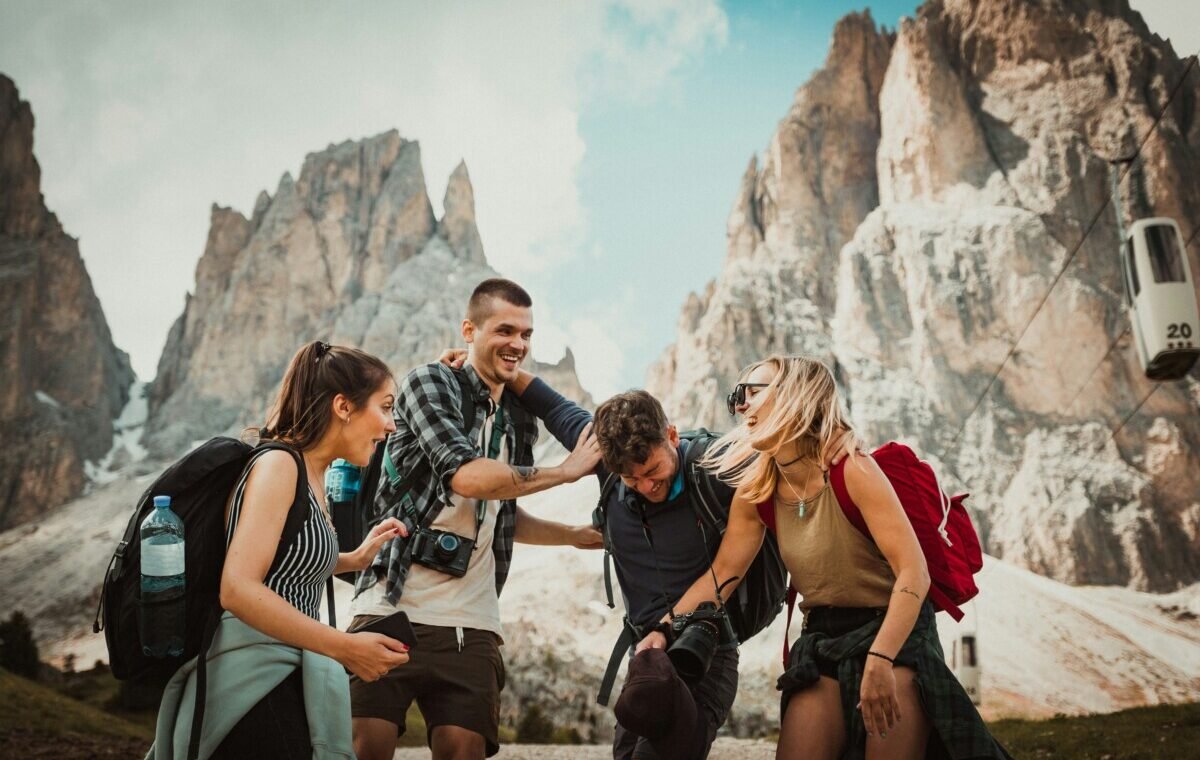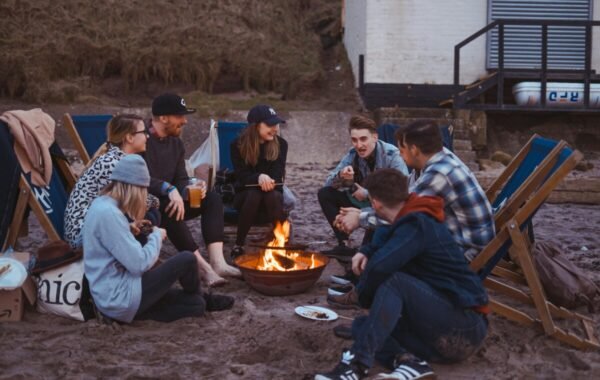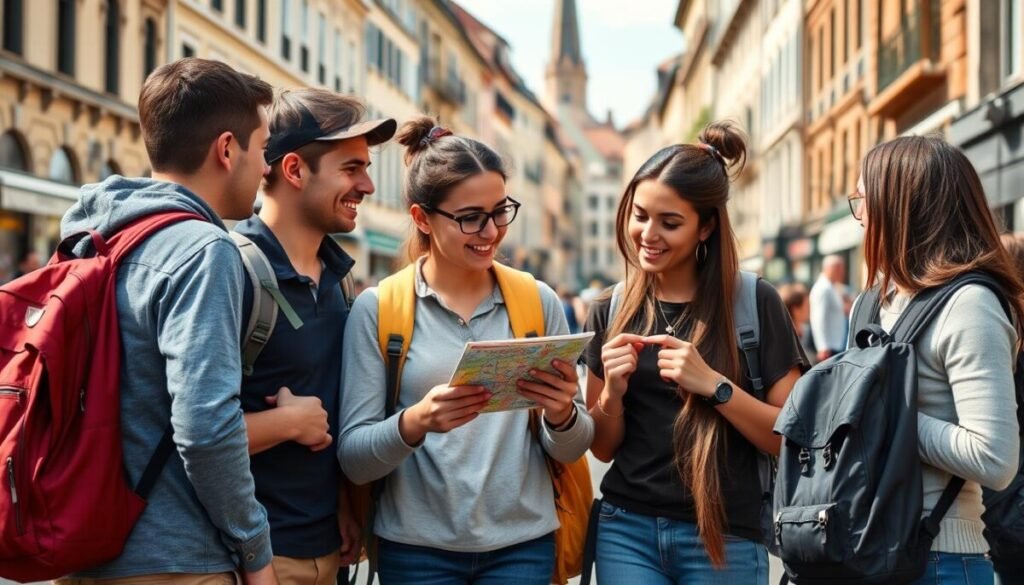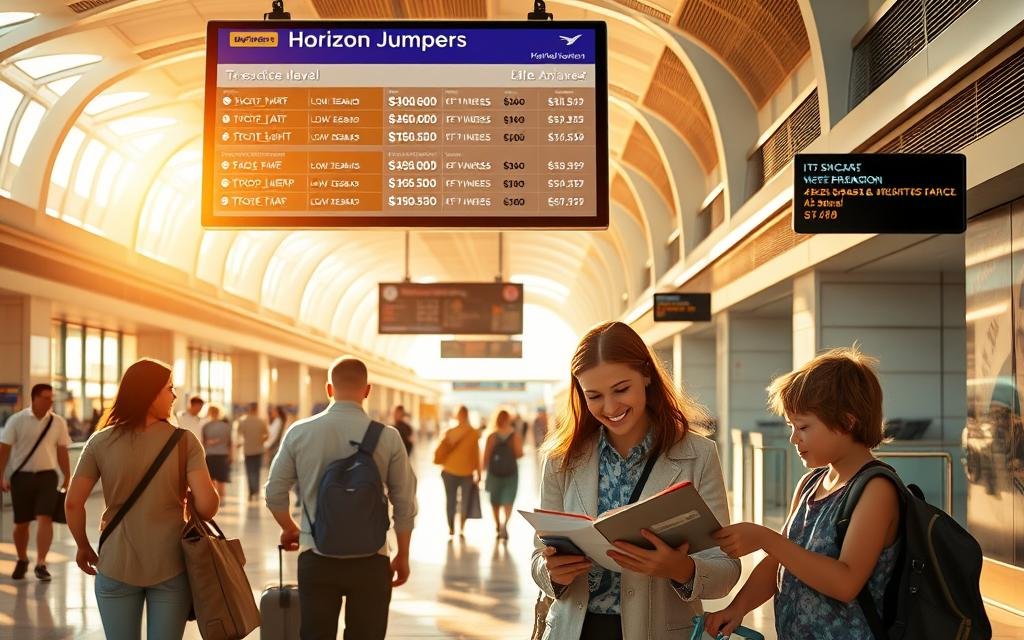
Return Travel – Making Friends
The Secret to Making Friends While Traveling? Return Travel
I used to think I was bad at making friends while traveling. I stayed in hostels and joined tours, but my connections felt shallow. Most talks ended with Instagram handles that didn’t lead to anything. Then, I found something that changed everything. The secret wasn’t being more outgoing or finding the perfect hostel. It was about going back to the same places.
Think about your closest friends at home. How many did you meet just once? Probably none. The same goes for travel friendships. When you go back to a place, you become more than just a tourist. Local café owners remember you. People you met before are excited to meet up again. You can build on old conversations instead of starting over. I now make real friends, not just meet people for a moment and these friendships last for years and cross continents.

Hi there! I’m Emily, a travel writer with a passion for exploring the great world we live in. I love to share my travel wisdom where possible to ensure people can truly make the most of the time when they visit places. One of my most memorable trips was Rio De Janeiro in Brazil, that city has some of the most wonderful, crazy energy!
Affiliate Disclosure: Some of the links on our site are affiliate links, meaning, at no additional cost to you, we may earn a commission if you click through and make a purchase. This helps us to continue providing valuable content and supports our efforts in bringing the travel community together. We only recommend products and services we believe in and think you’ll find useful. Complete details are included in our affiliate disclaimer. Thank you for your support!
In a Hurry? Here's our Key Info for This Article
- Return travel creates deeper connections than first-time visits
- Familiar faces are more likely to invest in lasting relationships
- Local businesses remember repeat visitors, creating natural conversation starters
- Previous conversations provide foundation for stronger bonds
- Revisiting destinations transforms you from tourist to community member
- Quality connections matter more than quantity when traveling solo
Essential Apps
Surfshark VPN
Stay safe online and continue accessing all your services just like back home.
Why Most Travelers Struggle to Form Lasting Friendships Abroad
After years of solo travel, I’ve found why making lasting friends abroad is hard. It’s not because travelers lack social skills or want to connect. The problem is how we approach relationships on our trips.
We often treat friendships like tourist spots. We check them off our list and move on. This makes both travelers and locals feel disconnected, even after meaningful encounters. Statistics show solo travelers often feel lonely, even when surrounded by people. This shows a big flaw in how we travel and expect to connect with others. Solo travel really does have it’s perks but building deep connections can be a tough one.
The Limitations of Single-Visit Travel
You ever notice how travel-based friendships are like “friendship false starts”? They feel promising, but they don’t have the foundation for a lasting bond. When you’re only in a place for a few days or weeks, you’re basically asking people to rush a relationship that usually takes months to grow. Think about your best friends back home, you didn’t become close overnight. That connection grew from shared experiences and trust. But when we travel, we expect to skip that whole process.
Why Tourist Chats Don’t Turn Into Real Friendships
Travel friendships can often feel like a bunch of “false starts.” You meet someone, and it seems promising, but you’re trying to build a lasting bond in just a few days or weeks. Think about your best friends back home, that connection grew over months of shared experiences, not overnight. When you’re a traveler, you’re essentially trying to skip that whole process. This isn’t just a “you” problem; locals are hesitant to invest in these relationships because they know most travelers will be gone soon. This time limit also restricts the kinds of things you can do together, so you miss out on the small, everyday moments that are crucial for building a strong friendship.
Why Return Travel Creates Stronger Bonds
Some friendship psychology studies show that returning to the same spot makes a huge difference in building strong bonds. It’s not just about seeing new places; it’s about making deeper connections. This science explains why certain travelers seem to make friends so easily abroad. It’s not about being lucky or super outgoing, it’s all about how we form those connections. So book that cheap flight and return to see what strong relationships you can build after some time and consistency.
Trust and Familiarity
One major finding in psychology is the mere exposure effect. Basically, the more you see someone, the more comfortable and familiar you feel around them. This totally applies to travel, too. For example, the first time I was in Lisbon, I was just another tourist. But when I went back for a second trip, the café owner actually remembered me. The bookstore clerk smiled when I walked in.
That small bit of recognition started a much deeper connection.Returning to the same place changes everything. You’re no longer just a tourist passing through. Locals start to see you as someone who truly values their community, which helps the initial awkwardness fade away.
Real friendships are built on shared experiences and memories. A single visit just doesn’t give you enough time for that. But when you keep returning to a place, everything changes.
For example, on my third trip to Bangkok, the conversations with my friends there picked up right where they’d left off. One friend, Som, remembered our talk about her grandmother’s cooking. Another friend asked for an update on my business project.
These kinds of shared memories are what create real friendships. They lead to:
- Inside jokes and references that bond you together.
- A mutual investment in each other’s lives.
- Trust that comes from consistent interactions.
- Emotional anchors that make you feel truly at home, even when you’re far away.
Breaking Through Cultural Barriers
Cultural differences can make connecting with people feel tough. Things like language, customs, and different worldviews can feel like walls between you and locals. But with enough time and consistency, you can actually break down those barriers.
For example, on my first trip to an Italian town, I felt like a total outsider. The customs seemed foreign and my conversations were pretty formal. But by my third visit, everything was different. People saw that I was genuinely interested in their community. They started sharing personal stories and traditions with me. I wasn’t just a visitor anymore; I was becoming part of their community.


Making Friends While Traveling
Going back to a place changes your travel experience. You start to feel like you belong. This is one of the best parts of returning to a place you love. I’ve seen this change many times. My second visit to a place was much different. People remembered my name and asked about my life. This change is not by chance. It comes from showing you care enough to come back.
From Tourist to Community Member
Getting seen as more than just a tourist can start a lot sooner than you think. On my first visit to a small town in Portugal, I was just another person asking for directions. But when I went back a second time, everything changed. The café owner remembered my coffee order, and the bookshop owner actually asked me about my writing.
I even got invited to a local festival, that was my real welcome into the community. When you return to a place, locals start to see you differently. You’re not just a tourist passing through; you’re someone who genuinely values their home.
Returning to a place lets you have much deeper conversations because you have a shared history to pull from. You can follow up on past chats or recommendations. These ongoing conversations are what build strong bonds. For example, on my second visit to Peru, I asked a guide about his daughter, which we had talked about on my first visit. Remembering this detail really strengthened our connection.
With each visit, you become a bigger part of the local community. People start sharing more personal stories and truly invest in getting to know you. This is what leads to real friendships. Instead of just talking about the weather, you start talking about life goals and dreams.
Creating Deeper Connections
Knowing you’re coming back changes everything for building friendships. People are more willing to invest in a connection with you because they believe it could last. Locals and expats are more likely to invite you to parties and other events because you’re seen as more than just a passing tourist.
This anticipation works both ways. You also invest more in these friendships, making plans for your next visit and staying in touch between trips. This mutual effort is what builds lasting relationships. Some of my closest friends started with a simple promise: “I’ll be back next year.”
| Aspect | First Visit Experience | Return Visit Experience | Relationship Impact |
|---|---|---|---|
| Local Recognition | Anonymous tourist | Remembered by name | Personal connection established |
| Conversation Depth | Surface-level topics | Personal stories and updates | Emotional investment increases |
| Social Invitations | Tourist-focused activities | Local events and gatherings | Community integration begins |
| Future Planning | No expectation of return | Anticipation of next visit | Long-term friendship potentially |
How to Choose and Plan Destinations
Not every place is good for making friends through repeat visits. I learned this the hard way. Some places just don’t have the right vibe for friendships. Choosing the right destination is key. Look for places that naturally bring people together. After trying many places, I found a way to pick the best ones for making friends. Look into planning your solo trip strategically, this will help with knowing how much time you have in each place.
Strong Community
Certain places just have a vibe that makes it easier to connect with people. Look for spots with active expat groups and a bunch of social events. Places with friendly locals and co-working spaces are also great for making friends.
To get started, I always check a place’s online presence. Active Facebook groups and meetups are a good sign of a thriving community. Cities with lots of co-working spaces and volunteer opportunities are your best bet for meeting people. I’ve found that small to mid-sized cities are way better for this than big ones, because you’ll see the same faces more often. Places like Antigua, Guatemala, and Chiang Mai, Thailand, are perfect examples. Also, be smart about where you stay, small inns and hostels with common areas and events are much better for meeting people than big, impersonal hotels.
Timing
The timing of your return trips is super important. Aim to go back about 3-6 months after your first visit. That way, people will have had enough time to miss you, but not enough to totally forget you. The seasons matter, too. Going back during the same season helps you reconnect with people you met when they were in their element. If you met someone during their busy season, try to go back then!
It’s also a great idea to time your visits around local festivals or events. This gives you a natural reason to talk to people and makes locals more friendly. Think about peak and off-peak seasons, too. Peak seasons are great for meeting a ton of new people, but off-peak visits are perfect for having those deeper conversations. I usually like to go during a peak season first, then return when it’s quieter.
Realistic Friendship Goals
When you travel, it’s a good idea to set some clear goals for each trip so you don’t get discouraged. For your first visit, maybe aim for just two or three solid connections. Remember, a few quality friendships are always better than a bunch of shallow ones. On that first trip, just focus on exchanging contact info and learning about people’s interests. Don’t expect to be best friends right away, that’s what your return trips are for.
When you go back, you can focus on deepening those relationships and meeting more of their friends. Plan activities with the people you met before; these shared experiences are what build lasting friendships. Be realistic about your progress. Not every person you meet will become a close friend, but if you stay in touch with even one person and feel welcomed back, that’s a huge success.
How to Meet Locals While Traveling and Stay Connected
Starting real connections while traveling begins with finding the right groups. It’s not just about meeting people. It’s about keeping those bonds strong. Building deep friendships abroad needs a plan. You must know where to find people, how to talk to them, and how to keep in touch.
Finding Local Communities
To find real local groups, you’ve got to steer clear of the tourist traps. Look for places where locals hang out during the week. A local gym is a great place to start; people will notice new faces and are often open to a quick chat. Weekly farmers markets are also perfect for meeting locals.
Community centers often have classes and groups for hobbies. I’ve made friends through pottery in Portugal and a book club in Prague. These places are specifically designed for people who want to connect. Neighborhood cafés are another perfect spot for regular meetups. Just make sure to choose a place away from the city center, where you’ll find more familiar faces and friendly baristas who remember your order.
Activities and Volunteer Opportunities
One-time events are great, but they don’t really lead to lasting friendships. You’re better off looking for activities that happen often and require a little more effort. Language exchange groups are perfect for this. They usually meet weekly and are full of locals who are genuinely interested in cultural exchange. You can find these groups easily on Facebook or apps like Meetup.
Volunteering is another great way to meet people and do some good at the same time. I’ve volunteered at animal shelters and local festivals, which gives you a common goal to work toward. If you’re into a specific hobby, look for clubs or classes. Things like photography walks or cooking classes attract locals who already share your interests, and these activities are designed to be more than a one-time thing..
Using Social Media and Apps
The hard part is staying in touch after meeting people abroad. I use different platforms to keep in touch. Instagram is my main tool for staying connected. I use local hashtags and share my travels. This helps me find and connect with people in each place. Facebook expat groups are community hubs. I find local events and reconnect with friends. I join groups before I arrive and stay active.
WhatsApp groups keep conversations going. I’ve kept in touch with hiking buddies in New Zealand and cooking friends in Thailand. The key is to stay consistent online. Regular updates and showing genuine interest in their lives are key. This builds lasting friendships across the globe.

Overcoming the Challenge of Feeling Lonely
Loneliness can totally sneak up on you when you’re traveling, even in the busiest places. I’ve felt completely alone in a crowded market in Bangkok and a bustling café in Barcelona. It’s that strange feeling of being surrounded by people but still feeling totally by yourself.
Many solo travelers deal with this, but you don’t hear about it much. Social media only shows the fun stuff, not those quiet moments alone in a hotel room. That’s where return travel comes in, it helps you fight loneliness by letting you build connections that make new places feel welcoming.
Emotional Anchors
Return travel gives you “emotional anchors”, people and places that just feel like home. When I land in Bangkok, I don’t get that lonely feeling I used to get in new cities. I know Sarah will be at the co-working space on Tuesday mornings, and Miguel will be leading his photography walk every Saturday. These are more than just things to do; they’re emotional anchors that make me feel like I belong.
These anchors grow over time. What starts as a casual coffee meetup turns into a tradition. A volunteer activity becomes a regular event where locals actually look forward to seeing you. These connections are what make you feel like you’re part of the community’s rhythm, and that’s something you just can’t get from a single visit.
Familiar Faces
Building a “global network of familiar faces” is a game-changer. It’s how you stay connected with people you meet abroad and really fight off loneliness. This isn’t just about having a few friends in different cities; it’s a whole web of relationships that offer support, local insights, and friendship no matter where you are.
Here’s how it grows with return visits:
- First visit: You meet cool people and exchange info.
- Between visits: You stay in touch through social media and texts.
- Second visit: You reconnect in person and deepen those friendships.
- Subsequent visits: You’re not a visitor anymore; you’re part of their regular social circle.
This kind of growth makes every return trip feel less like a visit and more like coming home to your friends.
| Aspect | Single-Visit Travel | Return Travel Strategy | Loneliness Impact |
|---|---|---|---|
| Social Connections | Surface-level interactions | Deep, ongoing relationships | Significantly reduced isolation |
| Local Integration | Always an outsider | Gradual community acceptance | Sense of belonging develops |
| Emotional Support | Limited to fellow travelers | Local friends provide stability | Consistent support network |
| Cultural Understanding | Tourist perspective only | Insider knowledge grows | Confidence reduces anxiety |
Managing Expectations
Learning to manage your expectations is a huge part of fighting travel loneliness. Relationships change, and not every connection will stay the same. People move, change jobs, or just grow in different directions. I’ve definitely returned to places expecting to pick up right where I left off, only to find that things have changed.
It’s important to go back with an open mind. This way, you can appreciate whatever connection is possible and be open to new friendships. Sometimes, the person you were closest to isn’t there anymore, but their friend becomes your new connection. Other times, your relationship with them might just deepen in an unexpected way.


Slow Travel Leads To Deeper International Friendships
I used to think making friends abroad was about visiting as many places as possible, but I was wrong. I was rushing through countries and missing out on real connections. The slow travel lifestyle completely changed how I build friendships while exploring.
This shift takes patience and intention. Instead of trying to see fifteen countries in a year, I now focus on five or six places. The result? The quality of my friendships has improved a ton.
Choosing Quality Over Quantity
My travel style completely changed once I started prioritizing depth over just seeing a bunch of places. Now, before I book a flight, I ask myself some key questions: Does this place offer a real sense of community? Can I see myself coming back here over and over again?
On my first visit to a new place, I now stay for at least three weeks. This gives me time to get past the main tourist spots and really tap into the local vibe. I make an effort to find neighborhood cafes, join a fitness class, or go to community events. Finding a place that matches your interests is also super important. If you love art, look for a city with a cool creative scene. If you’re into sustainability, find a place with a strong environmental movement. It makes all the difference.
Long-Term Planning
I’ve learned that a good travel strategy means thinking way beyond just one trip. I now plan my year around “anchor destinations”—places I’ve already been to and loved. These are the core of all my travel plans. I try to book my return visits about six months in advance. This gives my local friends something to look forward to, and it helps me snag better deals. I also coordinate my trips with friends to align with local festivals or other events.
Don’t forget to consider seasonal factors, either. Going back during different seasons shows commitment and gives you a whole new experience. Also always remember to grab some travel insurance before you fly, adding a hospital stop is not ideal when on your quest to make connections and enjoy yourself. My friends in Prague, for example, love showing me their city in both the summer and winter, and it’s a completely different vibe each time.
Finding the Right Balance Between Familiar and New
The biggest challenge for me is balancing new adventures with nurturing the friendships I’ve already made. I aim for a 60-40 split, about sixty percent of my time is spent returning to familiar places, and forty percent is for exploring new ones. This lets me satisfy my wanderlust while still giving my friendships a chance to grow. I also use new destinations to apply the lessons I’ve learned from my “anchor” locations. For example, the skills I picked up for connecting with people in Thailand helped me build a quick rapport with locals in Vietnam.
TP-405073Success Stories
Let me share some inspiring examples of how return travel turned casual encounters into lifelong bonds. These real stories show that you can make real friends when abroad by returning to the same places. Each story highlights different ways repeat visits can create lasting relationships.
From Stranger to Family Friend
My first visit to a small Tuscan village was memorable. I met Marco at a local wine festival. We talked about his family’s vineyard and exchanged numbers. I thought that was the end. Eight months later, I returned. Marco remembered me and invited me to his family’s Sunday dinner.
That meal changed everything. His mother taught me her pasta recipe, and his father shared village history. Now, three years later, I have a true Italian family. They’ve welcomed me many times. This travel friendship success came from returning instead of moving on.
Building Professional Networks
In Bangkok, return travel opened professional doors. My first visit led to meeting local entrepreneurs at a co-working space. We had casual coffee and connected on LinkedIn. Returning six months later, our casual connections deepened.
We started working together and sharing business opportunities. A friend introduced me to startup founders.These international connections have led to consulting contracts, speaking engagements, and investments. Showing up again proved my commitment.
Long-Distance Friendships
Some of my most meaningful friendships started in a Ho Chi Minh City Facebook expat group. Our first meetup was just coffee with five strangers. The conversation was nice but nothing special. Fast-forward two years and four return visits later, and we’ve become incredibly close. We’ve traveled to Cambodia and Thailand together and supported each other through job changes and relationship issues.
These people are my chosen family in Southeast Asia. When I have a problem, they’re the first ones I call. This kind of connection took time and consistency, and it was only possible because I kept returning. Every story like this shows that you can’t rush real friendships, but return travel can help you build them naturally.
Conclusion
I’ve shared my secret for making friends on the road, and it’s not about luck, it’s about putting in the time and effort. The real strategy starts with a change in mindset: instead of rushing to see as many places as possible, pick a few where you felt a real connection and plan to return with a purpose. This way, you’ll gain more than just friends; you’ll learn about local cultures and find emotional anchors around the world.
Start small by thinking of a place you’ve already been where you met someone interesting. Reach out to them before your next trip and plan activities that let your relationship grow naturally. Join local groups or volunteer in areas that you care about. These friendships will change how you see the world, leading to invitations to secret spots and family dinners, and a deeper understanding of a new culture. Your next trip can be about more than just brief encounters. Choose to go deep instead of wide, and invest in friendships that will last long after you’ve left. When you have friends waiting for you to return, the world feels a lot smaller and more welcoming.
Making Friends While Traveling FAQs
I usually plan my second visit 3-6 months after the first. This time is perfect. It’s long enough for people to miss you but not so long they forget you. It keeps the connection alive while you’re away.
Feeling lonely while traveling is common. I’ve felt it too, even in places full of people. Return travel creates emotional anchors. These are familiar faces and places that make foreign places feel like home. Focus on building a few quality connections. Remember, meaningful friendships take time to grow.
Look for places with strong expat communities and vibrant local cultures. Cities with active Facebook groups, regular meetups, and co-working spaces are great. Research destinations by checking online communities and the mix of locals and international residents. Make sure that your return destination is within your means, especially if planning to be there for a long time. Take a look at some expert advice from budget travelers on how to make your money go the extra mile.
Keep in touch through regular social media check-ins and sharing your travels. Facebook groups for expats are great for staying connected. Use Instagram stories and local hashtags to stay in touch with places and people.
I now focus on 5-6 destinations I return to regularly. I choose a few “anchor destinations” where I’ve already made connections. I plan my year so 60% of my travel is to familiar places and 40% is new.
I’ve learned to manage my expectations. Relationships change over time. People move, and connections may not be the same. Approach return visits with openness and appreciate whatever connection is possible
Look for regular gathering places like local gyms and markets. Join activities like language exchange groups and volunteer work. Apps like Meetup and Eventbrite help find activities to join during and after your visit.













